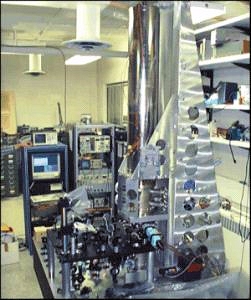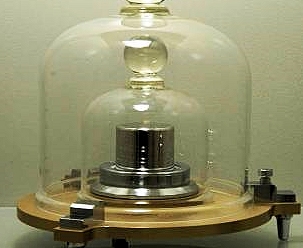

Og's Rock
Science is about making sense of the world around us by discovering the rules of the road. Verifying theories is where scientific rubber meets the road and for that we must make measurements. We have a nice system of international units used by every civilized nation to perform these measurements, but it hasn't always been so. We can imagine the first humans would have not needed extensive metrics. Distance measures would have been important for hammocks, posts for huts, and communicating how far away the buffalo herd was spotted. Counting might have been necessary to bring home enough fish for supper. The important units of times would have been days, moons, and seasons. The buffalo might be a day's walk toward the rising sun and hut posts should be at least as tall as Thor, except for Thor's hut (or he could just duck a little). Digits were convenient for reckoning the correct number of fish. Life was simple.
Then someone discovered how to cultivate grain which meant they didn't have to take down their huts and wander around when the deer and rabbit population dwindled. And life wasn't as simple, but it was better. People specialized and traded goods for grain. Distribution of labor raised the standard of living. But trading meant measuring things. Then came droughts and the solution was taxes. Everyone had to surrender a part of their grain in good years for distribution in lean times. And, of course there were a few people that tried to cheat on their taxes -- usually the very people that had more than their share anyway. They would make smaller bags or baskets so their ten bags of grain didn't stack up. And the solution was to measure things. So, the balance scales were invented. And then one guy, let's call him Og, came up with the idea of using a standard weight as a unit of measure -- Og's rock. Folks could re-create the standard unit using a simple clay pot and filling it with the appropriate amount of sand. A bit of candle wax on top sealed the container and Og's stamp made it official.

The first units of distance were body parts -- feet, hands (span), cubits, etc. (One exception, was of course, the bear-stick which is the length of the stick one chooses if one intends to poke a sleeping bear.) But once the need for more precise distance measure arose, an inanimate object such as a stick was likely chosen -- the rod. Time was a bit trickier. The shadow cast by the sun against a scale or the passage of sand through a funnel served as rudimentary measures of time until the pendulum clock was invented. But the base unit of the second is obviously the duration of a human heartbeat.
As cities and states arose, everyone came up with their own systems for measuring things making international trade an arithmetic nightmare. Those who could calculate took advantage of those who couldn't. And those that couldn't always suspected they were being cheated. In 1791 the Assemblee Nationale which included science and math luminaries like Laplace, Legendre, and Lavoisier, conceived the metric system or System International. The base unit for length was 1/10,000,000 of the pole to equator distance as then measured. The second was 1/86,400 of a day. And the kilogram was the mass of one cubic decimeter of water. Eventually the meter was replaced with a one meter bar and the kilogram with a kilogram chunk of metal. The second was eventually based on the tropical year which is an astronomical observation.

With the advent of electronics and quantum mechanics, time led the way to new and universal definitions. Now a second is defined as 9,192,631,770 periods of the radiation corresponding to the transition between the two hyperfine levels of the ground state of the cesium 133 atom. The meter was redefined as the length of the path travelled by light in vacuum during a time interval of 1/299,792,458 of a second. But the kilogram has not been so redefined. It is based on a chunk of platinum iridium alloy or the prototype kilogram kept in a French vault. In other words, it is just a polished version of Og's rock.

Prototype Kilogram (Og's Rock circa 1879)